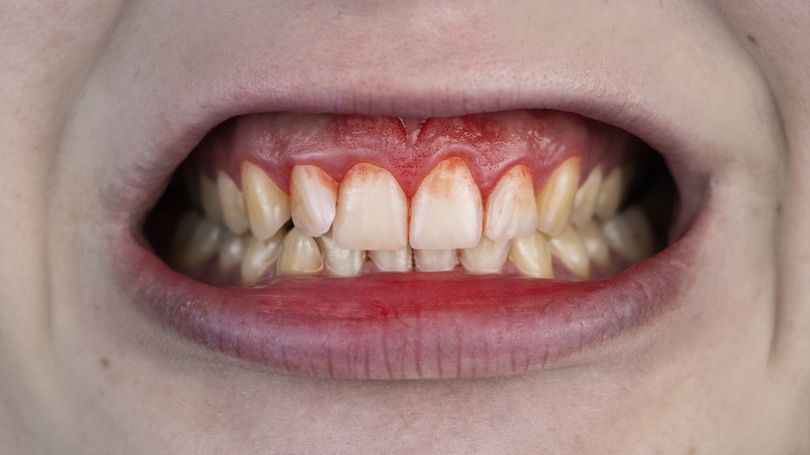What Is Gum Disease and How Do You Prevent It?

According to the Centers for Disease Control and Prevention, more than 47 percent of Americans age 30 and up have gum disease. It can cause halitosis and gums that are red, swollen, and tender. The disease can also progress to a more advanced stage that undermines the supporting bone and leads to tooth loss. Gum disease is, however, preventable, and all that is required is good oral hygiene.
The Cause of Gum Disease
Gum disease is caused by bacteria. There are many bacteria in your mouth, and when combined with food particles and saliva, it forms plaque, a colorless film that adheres to your teeth. The reason you brush and floss on a regular basis is to remove that plaque or least disrupt it. Left undisturbed, plaque calcifies into tartar, which is practically impossible to remove at home with basic oral hygiene.
The accumulation of both plaque and tartar contribute to gum disease. These substances build up along the gumline and infect the gums. Plaque can even spread below the gums where it is even more problematic, and this is often accelerated by tartar, which provides the plaque additional surface area upon which to accumulate. Initial gum disease is called gingivitis. Gingivitis is often reversible through better oral care, but it is often a silent disease, and symptoms do not manifest until it is more advanced.
Gingivitis that is left untreated will advance to periodontitis. Symptoms include persistent bad breath, receding gums, sensitive teeth, a painful bite or painful chewing, gums that bleed easily, and gums that are red, swollen, and tender. Gum recession causes pockets to form. These pockets become infected, and inflammation, as well as bacterial toxins, breaks down the gum tissue, connective tissues, and even bone. This damage cannot be reversed. The deterioration can be halted and managed, but prolonged periodontitis will require the teeth to be removed, or they will fall out on their own. Treatment often includes a deep cleaning known as root planing, and in some cases, surgery is required.
The Contributing Factors to Gum Disease
Although gum disease is preventable in all people, some people are more prone than others. Genetics is a factor, and if a parent had periodontitis, you might be at greater risk. People who eat a nutritionally deficient diet are at more risk because their immune systems are not as effective as they should be. Smoking, as well as the use of smokeless tobacco products, make you more prone to gum disease. Heightened and prolonged stress can be a contributing factor as well and must be managed.
Any disease that affects your immune system can make you more inclined to gum disease as well as accelerate and exacerbate any existing gum disease. People with type 2 diabetes are more prone to infection and, thus, gum disease. Gum disease can be harder to control in diabetic patients, and this can create a difficult cycle in which the gum disease also makes the diabetes harder to control due to unstable blood sugar levels. Pregnant women must also take care since they experience elevated hormone levels. This makes the gums more prone to gum disease, a condition known as pregnancy gingivitis.
Keeping Your Gums Healthy
Gum health is an important aspect of oral health, and your gums should be as much a focal point as your teeth. Consider that your gums play an integral role in supporting your teeth, so healthy gums make it much more likely that you can enjoy your natural teeth throughout your life. Gum disease will make it much more difficult to preserve your teeth into your golden years and can lead to other complications. Gum disease is linked to numerous systemic health issues, including cardiovascular diseases. The good news is that maintaining good gum health is not difficult and takes just minutes a day.
- Toothbrush—The American Dental Association (ADA) recommends a soft-bristled toothbrush not only to protect your enamel but to protect your gums. Brushes with bristles of varying heights can reduce irritation, stimulate your gums, and make it easier to get into those nooks and crannies.
- Toothpaste—The ADA also recommends using fluoride toothpaste with the ADA Seal of Acceptance. There are many products available with many different qualities, and you can discuss with your dentist which properties are good for gum health and how often to use such products.
- Floss—You should floss whenever you brush, so twice a day. Thorough flossing is imperative to good gum health. If you find conventional dental floss difficult to use, there are a number of alternative products available, including floss holders, floss picks, water flossers, and interdental brushes.
- Oral rinses—You can use an anti-gingivitis mouthwash. You can also rinse with salt water and, on occasion, hydrogen peroxide diluted with water. Be sure to discuss therapeutic oral rinses with your dentist because they are often best used occasionally rather than on a consistent basis.
- Gum stimulator—Gum stimulators are inexpensive and available at your local pharmacy. Not only do they stimulate your gums, but they can also help remove plaque and food particles. Using a gum stimulator is not an alternative to brushing and flossing, but it is an effective complement. You do need to replace the tip every three months or so—about the same time you change out your toothbrush.
- Biannual dental visits—Protect your gums by visiting your dentist every six months. Be mindful that gingivitis is often silent, so gums that look and feel great are not a good reason to skip a visit. Your dentist can identify any issues with your gums and teeth long before they manifest into something more serious. Your dentist can also adjust your oral hygiene routine for maximum effect.
Prevent Gum Disease
Dental science still has a great deal to learn about gum disease, but one fact is clear: preventing and managing gum disease will save your teeth. That fact alone is a great reason to take care of your teeth and gums on a daily basis. You can also count on Jeffrey D. Clark, DDS, to help you remain free of gum disease. The oral hygienists at Scottsdale Cosmetic Dentistry Excellence can remove plaque and tartar and make your teeth sparkle, and Dr. Clark can examine your teeth and gums and tweak your oral hygiene routine as needed. Call us today at 480 585 1853 to schedule your gum disease treatment near you.




